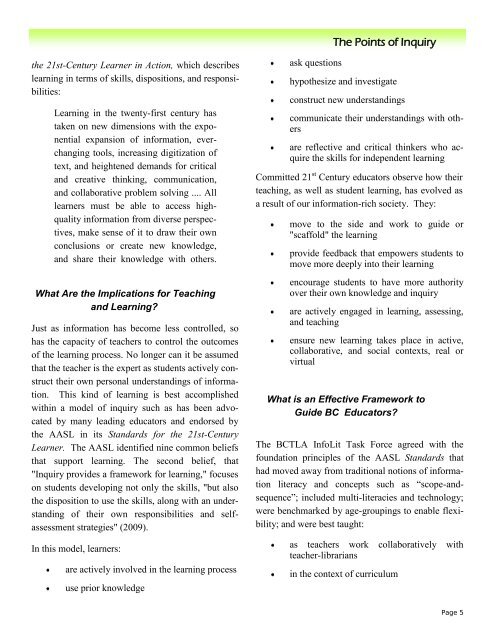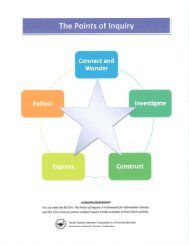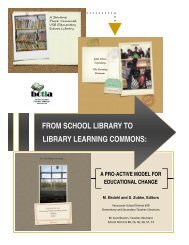PointsofInquiry
You also want an ePaper? Increase the reach of your titles
YUMPU automatically turns print PDFs into web optimized ePapers that Google loves.
The Points of Inquiry<br />
the 21st-Century Learner in Action, which describes<br />
learning in terms of skills, dispositions, and responsibilities:<br />
Learning in the twenty-first century has<br />
taken on new dimensions with the exponential<br />
expansion of information, everchanging<br />
tools, increasing digitization of<br />
text, and heightened demands for critical<br />
and creative thinking, communication,<br />
and collaborative problem solving .... All<br />
learners must be able to access highquality<br />
information from diverse perspectives,<br />
make sense of it to draw their own<br />
conclusions or create new knowledge,<br />
and share their knowledge with others.<br />
What Are the Implications for Teaching<br />
and Learning?<br />
Just as information has become less controlled, so<br />
has the capacity of teachers to control the outcomes<br />
of the learning process. No longer can it be assumed<br />
that the teacher is the expert as students actively construct<br />
their own personal understandings of information.<br />
This kind of learning is best accomplished<br />
within a model of inquiry such as has been advocated<br />
by many leading educators and endorsed by<br />
the AASL in its Standards for the 21st-Century<br />
Learner. The AASL identified nine common beliefs<br />
that support learning. The second belief, that<br />
"Inquiry provides a framework for learning," focuses<br />
on students developing not only the skills, "but also<br />
the disposition to use the skills, along with an understanding<br />
of their own responsibilities and selfassessment<br />
strategies" (2009).<br />
In this model, learners:<br />
are actively involved in the learning process<br />
use prior knowledge<br />
ask questions<br />
hypothesize and investigate<br />
construct new understandings<br />
communicate their understandings with others<br />
are reflective and critical thinkers who acquire<br />
the skills for independent learning<br />
Committed 21 st Century educators observe how their<br />
teaching, as well as student learning, has evolved as<br />
a result of our information-rich society. They:<br />
move to the side and work to guide or<br />
"scaffold" the learning<br />
provide feedback that empowers students to<br />
move more deeply into their learning<br />
encourage students to have more authority<br />
over their own knowledge and inquiry<br />
are actively engaged in learning, assessing,<br />
and teaching<br />
ensure new learning takes place in active,<br />
collaborative, and social contexts, real or<br />
virtual<br />
What is an Effective Framework to<br />
Guide BC Educators?<br />
The BCTLA InfoLit Task Force agreed with the<br />
foundation principles of the AASL Standards that<br />
had moved away from traditional notions of information<br />
literacy and concepts such as “scope-andsequence”;<br />
included multi-literacies and technology;<br />
were benchmarked by age-groupings to enable flexibility;<br />
and were best taught:<br />
as teachers work collaboratively with<br />
teacher-librarians<br />
in the context of curriculum<br />
Page 5






